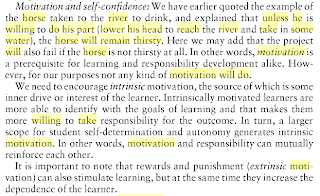 According to Scharle and Szabò (Learner Autonomy, A guide to developing learner responsability, page 7, see extract on your right), "unless [the horse] is willing to do his part[...], the horse will remain thirsty". The horse might of course be thirsty and not willing to lower his head to drink, but there is a chance it is not thirsty at all.
According to Scharle and Szabò (Learner Autonomy, A guide to developing learner responsability, page 7, see extract on your right), "unless [the horse] is willing to do his part[...], the horse will remain thirsty". The horse might of course be thirsty and not willing to lower his head to drink, but there is a chance it is not thirsty at all.This being said, one thing we deduce from this short passage, is that motivation is a prerequisite to learning.
One can be intrinsically or extrinsically motivated.
It is very important for students and people in general to have intrinsic motivation, the ‘motivation to engage in an activity for its own sake’ (Pintrich and Schunk: 2002: 245). Something inside you wants you to do something and pushes you to do it. There is an urge and a passion which keeps you going against all odds.
I firmly believe intrinsic motivation is the strongest of the two. This kind of motivation becomes a part of you in a way, and it makes you learn for the pleasure of learning. If a student is intrinsically motivated, his possibilities of succeeding in what he's doing will definitely increase.
As to extrinsic motivation, according to E.M.Forster, "as long as learning is connected with earning, as long as certain jobs can only be reached through exams, so long must we take this examination system seriously; if another ladder to employment was contrieved, much so called education would disappear, and no one would be a penny the stupider".
Would there be a decrease in motivation if students didn't have to learn in order to get something concrete (certificate, job, money....)? There probalby would, if the students are not engaged in what they are doing.
And here comes my next question: how can teachers engage and motivate their students?
Well, I guess a teacher should be motivated in the first place in order to motivate his/her students. There would be a lot to say about how teachers can motivate their students, and a lot has already been said.
Sugata Mitra said "if people have interest, learning happens" (see post - Sept 8th)
An engaging activity to set the grouds of a reasonably motivating lesson, could be the following game. It is called The Death of "I can't" (Raffini, J.,150 Ways to Increase Intrinsic Motivation in the Classroom) and I sometimes play it in my classes. Let me guide you through these three simple steps!
1. Write "I can't" on the whiteboard. Then ask your students to take a piece of paper and write down all the things that they can't do, starting every sentence with “I can't”. Give them a couple of minutes to complete the task (e.g. I can't speak English, I can't concentrate on the lessons, I can't remember new words, etc.)
2. When they're done, ask them to put their lists in a small box on your desk. Close the box and tape it shut.
3. Move your group to a remote area of the school property where you previously dug a small hole. Place the box in the hole and then read the following:
"Ladies and Gentleman, we are gathered here this morning to bid a farewell to a dear friend, someone whom we have grown to love and trust over the years, whose companionship we will miss dearly. It is with great sadness that we bid this farewell, for our lives will never be the same again. Yet, as sure as night follows days, our lives must go on and we must learn to live without our dear friend. Goodbye, "I can't."
In the future, should a student say “I can't” again, just remind them that “he's not with us anymore”!
